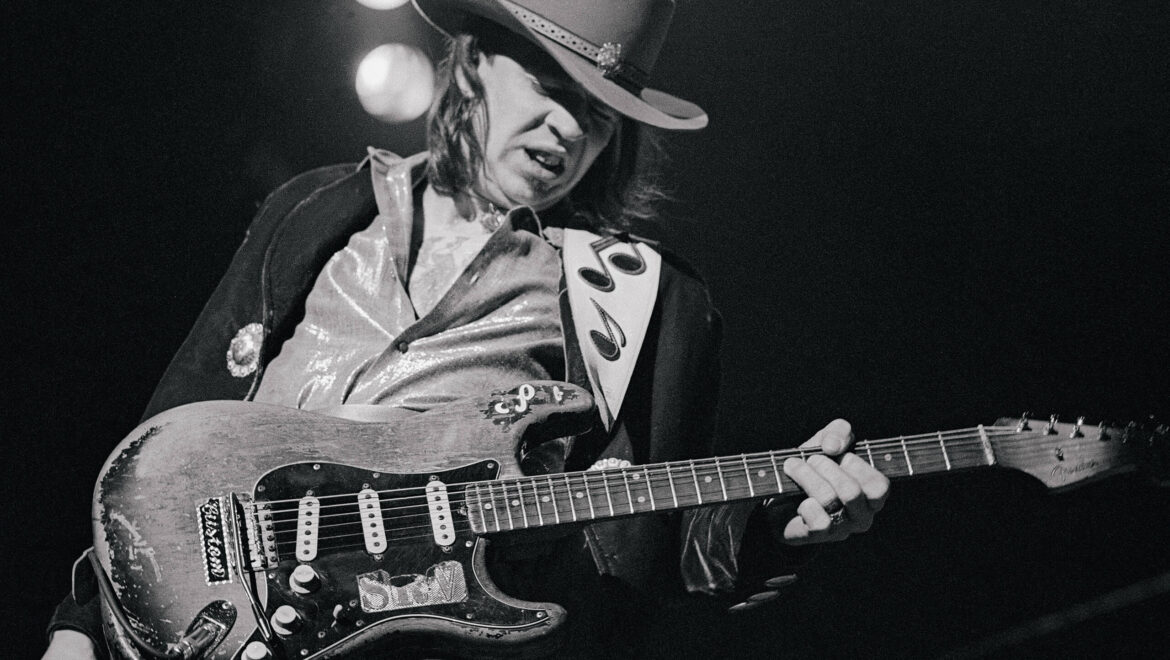Not everyone is a fan of the Blues, but you might be after listening to the best blues guitar players- like B.B King or Stevie Ray Vaughn. We encourage you to check them and others out on any of the streaming sites. Then, tell us, who you like.
In its earliest forms, Blues, particularly, rural Blues, is considered by most a primarily vocal form of music. It was designed not to tell a story necessarily, but to express a deep-seated melancholy. It is the lament wrought of terribly sad experience. The earliest practitioners’ styling is generally attributed to work—rhythmic chanting as one stuck, from dawn to dusk, behind the plow, keeping time to the cut of the soil; the cadence of one continuously filling his crocker sack under the hell of a hot sun to make a few dollars; or barking orders at the mule while staving off the sorrow of one’s own lot. The sound of his labor was the bluesman’s original accompaniment. When work was done, guitar, banjo, or harmonica were added to entertain the local audience.
Best Delta Blues Guitar Players
Contemporary blues owes much to the contributions of early Mississippi Delta Blues guitarists Charlie Patton and Robert Johnson.
Charlie (Charley) Patton
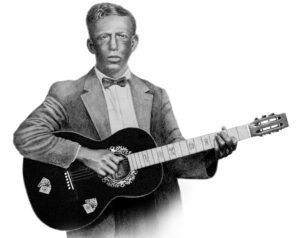
Born in the 1880s or 90s (records are a bit sketchy), Charlie (Charley) Patton is regarded by many as the Father of Delta Blues. Patton lived most of his life in Mississippi. Patton sang with a gravelly voice that could be heard a great distance and played an aggressive, heavily percussive style guitar. He was a quality showman and popular entertainer during his life and recorded nearly 70 songs including “Pony Blues,” “Shake It and Break It,” “High Water Everywhere,” and “Moon Going Down.” He was a major influence for many early bluesmen including Son House, Howlin’ Wolf, and Bukka White. He died in 1934 and is buried in a field in Holly Ridge, Mississippi. Patton was among the first inductees into the Blues Hall of Fame in 1980. The Rock and Roll Hall of Fame, however, didn’t recognize Patton’s influence on the genre until 2021.
Robert Johnson
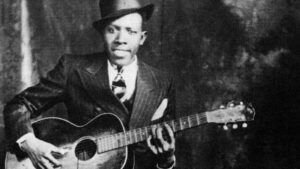
Best known for a masterful rhythmic slide guitar style and what has been described as an eerie falsetto voice, Robert Johnson played alongside some of the biggest blues performers of his time. Though most initially saw him as a subpar player, Johnson left Robinsonville, Mississippi and returned some time later a masterful guitarist. Music Historian Robert Palmer attributes the change to Johnson learning from Ike Zinneman (not the result of some fiendish bargain). Unlike others during the period, Johnson’s compositions were tight and lyrical. He penned “Me and the Devil Blues,” “Hellhound on My Trail,” “Love in Vain,” “Sweet Home Chicago,” “Terraplane Blues,” and “Ramblin’ on My Mind.” His limited recordings were made over a period of only seven months in 1936 and 1937. Johnson died in 1938 from an unknown cause. He was 27. Like Patton, Robert Johnson was an initial inductee into the Blues Hall of Fame. Bob Dylan, Eric Clapton, Keith Richards, and Robert Plant all credit Johnson as an influence, which may explain why he was also inducted into the Rock and Roll Hall of Fame in 1986, where it was said Johnson may have been “the first ever rock star.”
Sister Rosetta Tharpe

The “Godmother of rock and Roll,” Sister Rosetta Tharpe fused Gospel and blues, boldly took Gospel into secular clubs, and was among the first to incorporate the use of distortion in her guitar playing. Tharpe played her Gibson with the confidence and skill normally attributed to male guitarists. These combined to make her an innovator, an easy crossover performer, and a significant influence on a host of future performers—Little Richard, Jerry Lee Lewis, Chuck Berry, Tina Turner, and Eric Clapton among them. Elvis Presley and Johnny Cash both counted her among their favorites. She had multiple hits from her first recording in 1938 including “That’s All” and “The Lonesome Road.” In 1945, she recorded “Strange Things Happening Everyday.” Catching the ears of secular audiences, the gospel recording landed on the “race records” chart (now R&B). Further, it is considered by some to be “the first rock and roll record.” Tharpe continued to perform until her death in 1973. She was inducted into the Blues Hall of Fame in 2007, In 2018, Tharpe was indicted into the Rock and Roll Hall due to her undeniable influence.
B.B. (“Blues Boy”) King
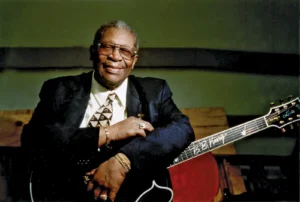
B.B. (“Blues Boy”) King, though self-taught, brought sophistication to the blues with his string bending and vibrato-infused solos and vocals that perfectly matched his impressive playing. Like many greats, King was from the Mississippi Delta. He began playing an acoustic guitar, but transitioned to electric after hearing T-Bone Walker perform. He shared, I “’Had’ to have one, short of stealing!” He first hit the R&B Charts with “3 O’Clock Blues” in 1952 and followed that with 73 others over his long career, including “The Thrill is Gone” (which also reached number 15 on the Billboard Hot 100) in 1969. King was a tireless performer who averaged more than 200 shows per year well into his 70s and continued to perform until months before his death at age 89. He performed and/or recorded with most of the greatest musicians from 1945 to 2008 and was, according to AllMusic’s Bill Dahl, “the single most important electric guitarist of the last half of the 20th century.” It is no accident that he is hailed “King of the Blues.” King won 15 Grammy awards, was inducted into the Blues, National Rhythm & Blues, and Rock and Roll Halls of Fame, is a Kennedy Center honoree (for his lifetime contribution, as a performer, to American culture), and was awarded the National Medal of Arts (the highest honor given in the field of the arts by the US Government), and the Presidential Medal of Freedom (awarded by the President to those who with “an especially meritorious contribution to the security or national interests of the United States, world peace, cultural or other significant public or private endeavors”).
Best Texas Blues Guitar Players
Stevie Ray Vaughan
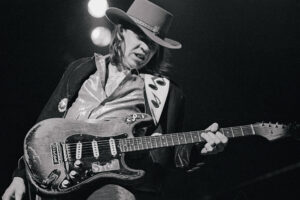
In the main, Stevie Ray Vaughan’s career spanned only seven years. During that time, he recorded four studio albums and garnered seven Grammy Awards. He is considered the primary reason for the Blues revival of the 1980s. He taught himself to play by listening to a number of blues, rock, and jazz guitar greats. Committed to music, Vaughn quit high school and dead end jobs to devote himself to his craft. He bounced from band to band through the 70s and jammed with the likes of Buddy Guy, Lightnin’ Hopkins, and Albert King. In 1978, he formed Double Trouble and, when in 1982, they played the Montreux Jazz Festival, People Magazine reported of SRV, “he seemed to come out of nowhere… with a ’59 Stratocaster at his hip and two flame-throwing sidekicks he called Double Trouble. He had no album, no record contract, no name, but he reduced the stage to a pile of smoking cinders….” In 1983, Vaughn was asked by David Bowie to play guitar on Let’s Dance, which no doubt brought him some major recognition. Later that year, Double Trouble recorded Texas Flood. “Texas Flood,” “Love Struck Baby,” and “Pride and Joy” (the latter two written by Vaughn) were all hits and the album sold half-a million copies. SRV and Double Trouble finally made the main stream. In response to the band’s second album, Couldn’t Stand the Weather, AllMusic’s Stephen Thomas Erlewine wrote the album “cement[ed] Vaughan’s status as a giant of modern blues.” Tragically, he died in a helicopter crash on August 26, 1990 at the age of 35. Stevie Ray Vaughn was inducted into both the Blues and Rock and Roll Halls of Fame and won the W.C. Handy/Blues Music Award, the highest honor bestowed upon blues performers and songwriters, five times. guitarworld.com says of SRV, he “defined the sound of contemporary blues guitar.” To prove it, they offer 20 different techniques he employed as a blues virtuoso. SRV also made our list of the top guitar players of all time.
Joe Bonamassa

At age 12, Joe Bonamassa opened for B.B. King. That’s a helluva way to kick off a career and it speaks volumes of his development as a blues prodigy. Several decades later, AllMusic’s Mackenzie Wilson writes, Bonamassa is “an undisputed guitar hero, the most popular blues-based six-string slinger of his generation.” Blues Guitar Insider writes, “any blues guitarist today has to admit that everyone who has come before is an influence. Bonamassa may be the best example of a blues guitarist who is a jambalaya of all the greats. You can practically taste it in his playing.” He has recorded fifteen albums on his independent record label and eleven of them have made the top of the Billboard Blues Charts. He has performed with all the blues greats, young and old, since the 1990s and has been nominated for a Grammy Award three times. Many more accolades will follow Bonamassa as he continues to prove himself as one of the best blues guitar players of all time.
There is no doubt that other blues greats could have been included in this list. Many have been referenced as influencers of those included or who were influenced by them. We have simply tried to point to those who personify various eras from the 1930s to the present. There is no doubt others are already making a name for themselves. Ally Venable, Eric Johanson, Quinn Sullivan, Jackie Venson, and Joanne Shoe Taylor are among the folks to watch as the new wave of blues guitarists.

